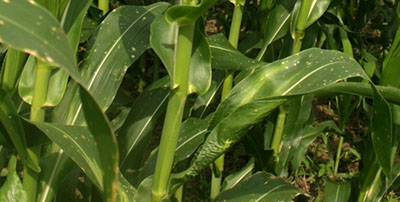Causes and effects of boron deficiency in corn, soybeans, and cereal grains
Boron deficiency is a serious issue that can affect the yield and quality of commodity crops. Without adequate boron, plants are unable to complete their life cycle. But what does a deficiency look like and why is it so important for plant growth? Causes and effects of boron deficiency, and the best ways to address it, are different in every crop.
Causes of boron deficiency in commodity crops
When a crop is boron deficient, the signs vary depending on the plant, but one element remains the same for all commodity crops—deficiencies appears on the youngest leaves first. This is because boron remains immobile in most commodity crops, resulting in a stunted growth and poor development.
Boron deficiency in commodity crops can be found initially by a variety of indicators:
Corn
Severe boron deficiency results in short bent ears of corn with under-developed tips and very poor kernel development. Yellow or white spots develop between the veins on young leaves, and the spots often combine forming streaks.

Soybeans
In soybeans, the root tips die, and new roots are initiated giving a rosette appearance. Likewise, the death of the shoot growing point is followed by prolific development of lateral shoots with brittle petioles.

Cereals
Small chlorotic spots form between the veins of the youngest unfolded leaves in cereal crops. The spots enlarge and coalesce to form the characteristic white stripes.
Effects of boron deficiency in commodity crops
Boron deficiency can cause significant yield loss in commodity crops, leading to fewer economic returns for farmers. Symptoms of deficiency include stunted growth and poor root systems, but can also be more subtle, such as discolored or weak petioles.
For farmers, it's important to identify and address boron deficiency as soon as possible. The best way to do this is to take a soil test followed by an in-season tissue sample to determine crop available boron.
Boron is not mobile in the plant, so soil and tissue tests are important to determine whether boron at optimal levels in your crop. If you suspect that you have boron deficiency, it might be too late to make up the difference with additional fertilizer applications. If you find that your crop is indeed deficient in boron, taking steps to increase plant available boron is the first step to help prevent future problems.
Boron deficiency is a serious issue that can significantly impact the yield and quality of commodity crops. It's vital to understand the causes and effects of boron deficiency in order to find the most effective ways of addressing this issue. Applying boron to the soil or using foliar sprays are some of the most effective methods of correcting boron deficiencies in crops. Furthermore, it's important to ensure that there is an adequate supply of boron for crop growth, as it is essential for many metabolic processes.
If you have questions or want more information, stop by booth 1143 at the Commodity Classic in Orlando, FL from March 9-11. Ignoring the signs of boron deficiency can be costly, so don't delay in checking your crops!
Resources